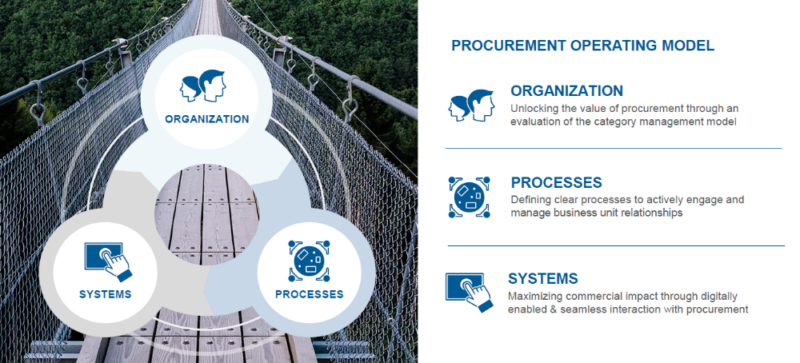The COVID-19 pandemic has caused an immediate drop in advertising and media spending. While the industry is set to assume more normal activity in the second part of this year, the pandemic has forced a rethink on cost management in its recovery. With an ever-increasing focus on costs, advertising and media firms are taking a closer look on procurement function as a driver of value and innovation. As procurement within this sector traditionally operates in a mostly transactional fashion, there is a need to accelerate the transformation of the procurement operating model to deliver value in new ways.
What is the role of procurement in the media and advertising sector?
Across leading advertising and media firms, procurement traditionally plays a very reactive role with limited strategic influence. Typically, only few contracts are negotiated centrally, while a significant proportion of indirect and direct spend categories are managed by budget holders and sometimes local procurement that sit at the business unit level or within disparate operating companies.
Centrally managed contracts typically cover procurement spend areas such as travel, professional services, insurances and integrated facilities management. Group procurement functions would gather requirements from the business in order to find suppliers that can meet the needs. Key challenges faced by central procurement teams include being involved reactively or standardizing too much to the point of being out of touch with the business, resulting in non-compliance to contracts and maverick buying.
On the other end of the spectrum, direct spend categories remain outside of the control of procurement and instead managed at the business unit or operating company level directly by budget holders. These categories include research operations, design, production and media, typically contracted at a project level. Budget holders tend to not be aware of the contribution from procurement, so they tend to only engage procurement, if at all, in the final negotiating and contracting stages of the purchasing process. However, in these instances, the most opportune time to add value has already passed.
Without the involvement of procurement in controlling spend there is lost opportunity for economies of scale, underutilization of the negotiation expertise of procurement teams and potential supply chain risk. While some direct costs are ‘passed through’ to the customer, robust procurement spend management is increasingly becoming a key contributor for revenue generation through delivering services into the market efficiently and cost effectively.

Organization: Rethinking the category management model
Unlocking the value of procurement in the advertising and media sector requires an evaluation of the category management model and subsequent re-design of the procurement organization structure. There are often benefits from decoupling local procurement activities and centralizing them into a center of excellence model.
Three dimensions are used to design the category management model. Each of these will influence the organization design and determine whether a category should be
- managed at the local level without involvement from central procurement,
- centrally coordinated by lead buyers supporting local business units), or
- managed centrally through dedicated category managers.
Local Category Specifics: If there is common demand across regions, for example translation services and fleet, there is opportunity to standardize and manage centrally. On the contrary, for other categories such as production with local specifics, it makes sense to manage at the local level
Supply Market: If the supply market is regional or global, for example market research and legal services there is opportunity to leverage volume across markets and negotiate centrally. Where there is a local supply market such as events space, it may make sense to be managed at the local level.
Criticality: If a category is highly strategic, you may consider managing it close to the business it impacts, in a decentralized manner. On the contrary, categories that are least strategic will often be managed at a corporate level to maximize standardization and allow efficient demand management.
Processes: Defining clear processes to actively manage business unit relationships
Key challenges faced by advertising and media firms include lack of compliance to contracts and maverick buying by the BU resulting in uncontrolled spend and value leakage from procurement negotiated contracts. The main culprit for this is that procurement teams do not account for the local nuances and specifics of requirements sought out by the business. It then becomes critically important that procurement define clear processes to actively engage and manage business unit relationships.
Procurement processes need to be integrated with the business at both the front end and the back end. At the front end, procurement teams need to aid the business units in developing sourcing strategies very early on and deeply understanding local requirements specifics and project nuances. On the back end, processes need to be defined to ensure compliance with procurement processes and contract terms to fully realize benefits.
To develop a culture of strategic collaboration, CPOs need to recognise they cannot do it alone. They need to continuously sell sourcing and category management to business stakeholders and senior leadership to move toward strategic collaboration. This may initially be met with resistance therefore procurement must progressively demonstrate how it can deliver competitive advantage on a project level initially before being seamlessly integrated into the business units.
Systems: Empowering business end-users to maximise commercial impact
While centralizing more spend and defining processes to manage business relationships can drive more procurement control, technology is a key enabler in gaining business buy-in and influencing spend that historically has been out of reach for procurement. As advertising and media firms typically do not adopt top-down cultures, if technology makes it comfortable for the business to make use of procurement services, driving compliance and expanding the reach of the function becomes easier.
Procurement technology plays a role in putting the power back into the hands of the end user through an easy to use and robust system where the business can transform procured goods and services into value. For example, one of the largest spend areas for advertising and media firms are freelancers, and vendor managed systems (VMS) are transforming the way in which businesses use technology solutions to source and maintain visibility across their extended workforce. End users are empowered with full transparency and analytic insight, such as market pay rates of their freelancer workforce, which increases their likelihood to comply with procurement processes and manage cost. Meanwhile procurement is assured that there is supplier competition, compliance with negotiated rates and compliance with complex tax and regulatory labour laws.
Similarly, guided buying platforms offer online portals where end users can self-serve from a display of products, ranging from office suppliers to IT hardware, that are pre-approved by procurement teams. These platforms remove the uphill battle procurement teams face in ensuring user compliance and provides an easy and intuitive way for business to quickly source what they need and re-focus on core business activity.
A procurement operating model reimagined
Advertising and media firms that opt to reimagine their procurement operating model will change procurement’s influence in the organization and allows teams to deliver value in new ways. There are three main ways of doing so:
- Organization: reevaluating the category management model
- Processes: ensuring the right level of business engagement across front and back end processes
- Systems: driving compliance and maximizing commercial impact through digitally enabled and seamless interaction with procurement
Reimagining this new operating model can be a complex exercise however deeply worthwhile to truly unlock the potential of the procurement function, drive value and deliver services into the market efficiently and cost effectively.


